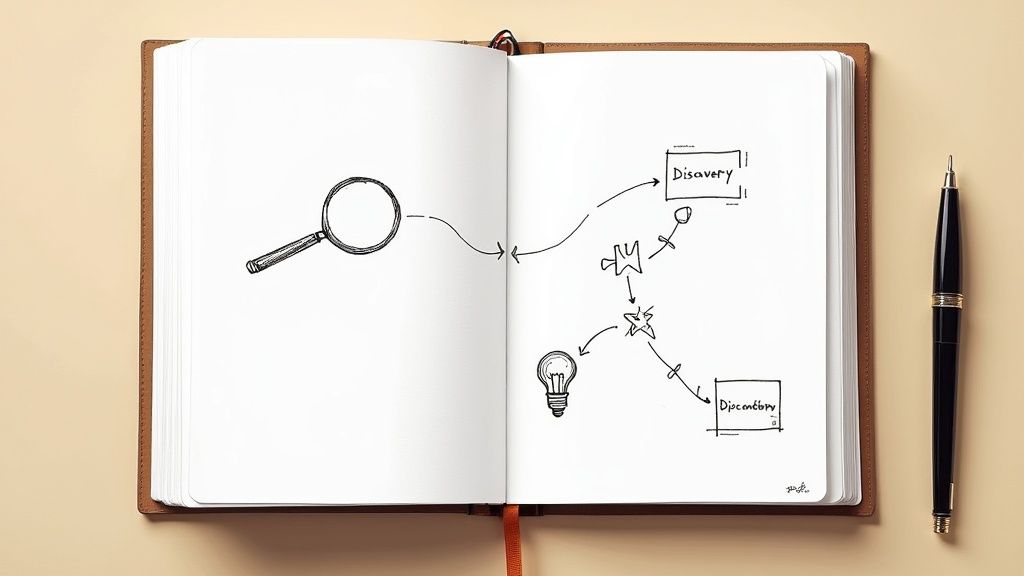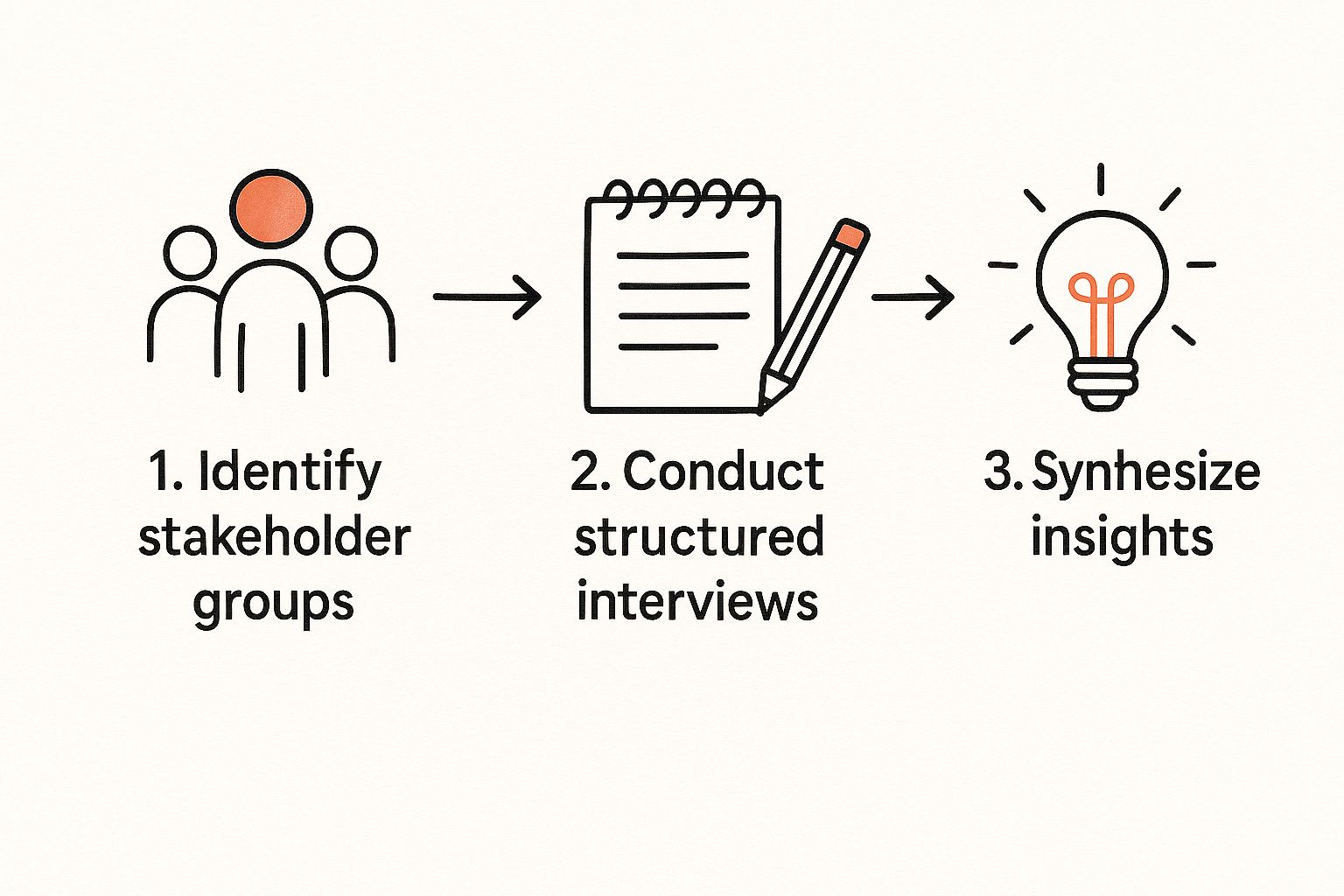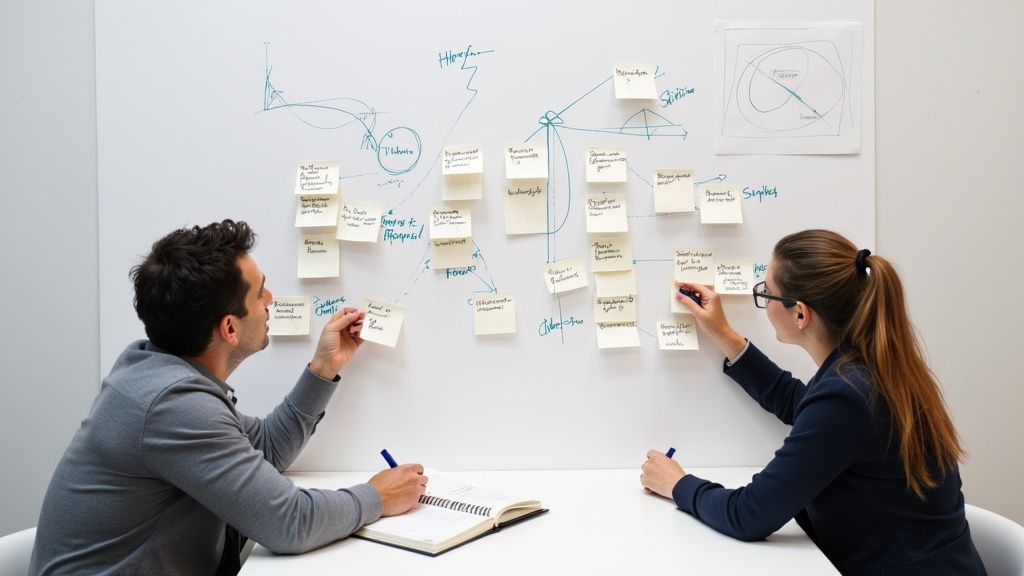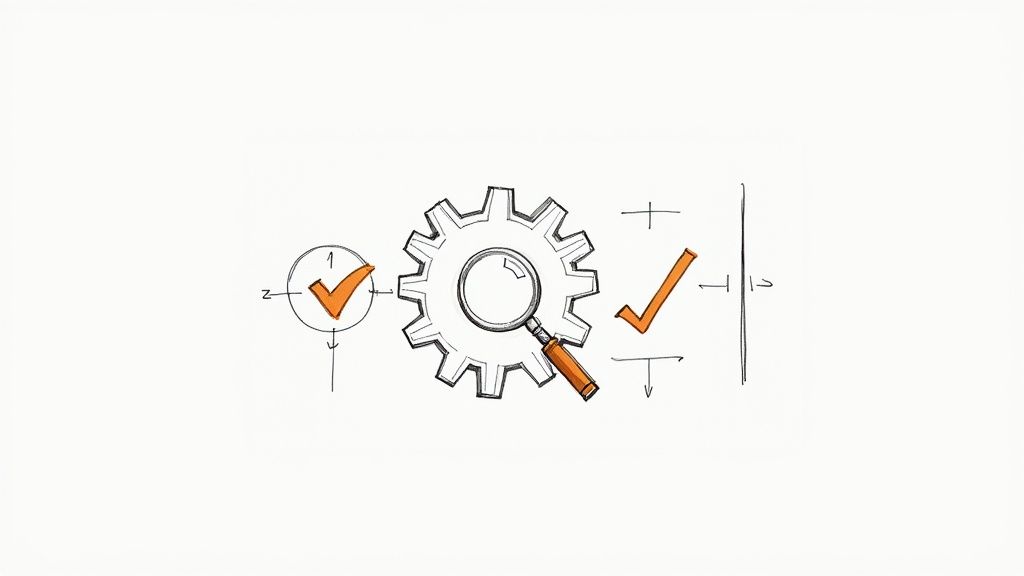A Guide to the Software Development Discovery Phase
Discover how a disciplined software development discovery phase prevents costly mistakes. Learn our structured approach for project clarity and success.
Posted by
The software development discovery phase is your project’s blueprint. It’s a disciplined process for defining the problem, setting clear boundaries, and aligning your team before a single line of code is written. It ensures you’re solving the right problem from day one.
Framing Your Project Before You Build

Imagine an architect mapping out a house’s essential boundaries before construction begins. That's the discovery phase. This isn’t about creating a massive, rigid document that shatters on contact with reality. Instead, it’s about establishing clear guardrails and a shared understanding.
At Inovo, we’ve built our discovery process on the principles of Ryan Singer's Shape Up, a methodology we trust and have refined through direct work with him. A key practice is Framing, where we collaborate with clients to build the project's boundaries together.
The Power of Clear Boundaries
Framing stops wasted effort by answering a few critical questions upfront.
- What problem are we really solving? We take raw input—call transcripts, spreadsheets, scattered ideas—and distill it into a sharp, well-defined problem statement.
- What is our appetite? Instead of asking "how long will this take?" we ask, "how much time is this problem worth solving?" This sets a fixed time budget (our appetite, typically 1-6 weeks), forcing smart trade-offs.
- What does a "win" look like? We define the tangible outcomes that will make this project a success.
- What are we not doing? Just as critical is defining what’s out of scope. This is our defense against scope creep and keeps the project from getting derailed.
A well-executed discovery phase is a strategic investment. Spending quality time here dramatically improves your chances of success. Industry analysis shows that thorough discovery can slash overall development costs by preventing expensive rework and aligning business goals with technical strategy from the start.
To see why this is so critical, it helps to understand where discovery fits into the larger software development life cycle's five phases. This context clarifies why a solid, validated plan is non-negotiable for building great products without wasting time and money.
This, Not That: Modern Discovery vs. Traditional Requirements
It's important to distinguish our modern, collaborative approach from old-school "requirements gathering." One is about exploration and alignment; the other is a one-way street that leads to bloated, rigid documents.
Here’s the difference:
| Aspect | Modern Discovery (This) | Traditional Requirements (Not That) |
| Goal | Shared understanding and risk reduction | A comprehensive, exhaustive specification document |
| Process | Collaborative, iterative, and flexible | Linear, formal, and rigid |
| Output | A focused problem frame with clear boundaries | A detailed list of features and "shall" statements |
| Team Role | Active partners in shaping the solution | Order-takers executing a pre-defined plan |
| Client Role | Hands-on collaborator in defining scope | Provides requirements upfront |
Ultimately, a modern discovery phase is a dynamic conversation that sets the project up for success by focusing on the why and the what, not just an endless list of features. It’s a fundamentally different mindset.
The Core Activities of a Successful Discovery
A great discovery phase is where a vague idea becomes real enough to build. At Inovo, we follow a structured process inspired by the Shape Up method. It all comes down to two key stages: Framing and Shaping.
These activities aren't about creating a mountain of paperwork. They’re about creating absolute clarity and sniffing out risks before they become expensive problems.
First, we Frame the work. This sets the boundaries with our clients from the start. We nail down a sharp problem statement and then set a fixed appetite—how much time is this solution worth? Usually, it's a one to six-week cycle. This creative constraint forces everyone to make tough decisions early and focus only on what delivers the most impact.
From Problem to Potential Solution
Once the problem is framed, we move on to Shaping a potential solution. This isn't the time for pixel-perfect mockups or detailed technical specs. Instead, we use rough, high-level tools like "fat marker sketches" and "breadboards" to map out the main components and how a user moves through them.
These sketches are intentionally abstract. They provide just enough detail for a small, autonomous team to run with the idea, but not so much that it stifles their creativity. Shaping is about exploring what's possible within our appetite, spotting potential rabbit holes (risks), and ensuring the solution fits the time budget. It gives the team a clear destination with the freedom to find the best path.
The discovery process turns raw input into a clear, actionable plan.

This shows how successful discovery isn't a series of random meetings. It’s a disciplined approach to identifying stakeholders, gathering information, and turning it all into a coherent strategy.
The Human + AI Approach to Shaping
At Inovo, we amplify our shaping process by bringing AI into the mix. This doesn't mean an algorithm runs the show. We use AI as an accelerator, a tool that helps us explore more ideas in less time.
Here’s what our Human + AI partnership looks like:
- AI for Rapid Exploration: We feed the framed problem to an AI and have it generate multiple breadboards or user flows in minutes. This lets us see several potential paths side-by-side.
- AI for Risk Detection: AI is great at spotting patterns. It can analyze a proposed solution and flag potential "rabbit holes" or technical hurdles we might not see at first glance, de-risking the project early.
- Humans for Strategic Judgment: Ultimately, our team makes the final calls. We use our experience to decide which concept best fits the appetite, what needs to be cut, and which direction aligns with the client's goals. Humans guard the boundaries.
How AI Amplifies the Discovery Process
Traditional discovery can be a slog: days of poring over documents, interview notes, and spreadsheets by hand. We take a different route with our Human + AI approach. AI acts as a turbocharger for our team's expertise, helping us move faster and dig deeper—not as a replacement for human judgment.

This powerful combination supercharges both Framing and Shaping.
Faster Framing with AI Assistance
The Framing stage is about getting to the heart of the problem. A client might give us a mountain of raw input—interview transcripts, complex spreadsheets, and scattered documents. Manually synthesizing that could eat up a week.
That’s where AI does the heavy lifting:
- Rapid Synthesis: We feed unstructured information to an AI, which digests it and returns a clear summary of core problems and desired outcomes. This condenses hours of raw client input into sharp insights.
- Theme Identification: AI is brilliant at spotting patterns, highlighting common pain points and recurring themes in minutes, not days.
Broader Exploration in Shaping
Once the problem is framed, we Shape a solution. Here, AI acts as a brainstorming partner on steroids.
Instead of one person spending a day whiteboarding a single user flow, we can ask an AI to generate five different "breadboard" concepts in an hour. This lets us see a wider range of possibilities from the start and quickly spot potential rabbit holes before we waste time on them.
The final call, however, is always human. Our team vets the AI-generated ideas, weighs them against the project's appetite, and makes the tough trade-offs needed to align the solution with real-world business goals. AI generates options; humans own the architecture, integration, and shipping.
Key Deliverables That Cut Down Project Risk
What do you actually get at the end of a discovery phase? Not a dusty instruction manual, but tangible documents that act as a roadmap for the entire project.
These deliverables are designed to create alignment and systematically squash risk before a single line of code is written. The goal is just-enough documentation—a clear map for the development team, not a rigid plan that breaks at the first challenge.
Turning Vague Ideas into a Solid Plan
The outputs from discovery are decision-making tools. They prove that real progress is happening long before the first feature is built.
Here’s what you can typically expect to have in hand:
- A Validated Problem Statement: A crisp, one-page summary nailing down the exact problem you’re solving, for whom, and why it matters.
- Defined Appetite and Boundaries: A clear time commitment (like a six-week cycle) and, just as importantly, a list of what you're intentionally not doing. This "no" list is often the most valuable piece.
- User Journey Maps: Simple diagrams showing the main paths a user will take through the software to solve their problem.
- Fat Marker Sketches or "Breadboards": Low-fidelity sketches mapping out the essential UI components and how they connect, without getting lost in design details.
- Identified Risks and Rabbit Holes: A clear list of potential technical hurdles or complex areas that need careful consideration during the build phase.
These artifacts represent a real return on investment before development kicks off. They give you decision-ready materials that test assumptions, prioritize what to build, and spot roadblocks early.
This process creates a blueprint that makes all later work smoother and more efficient, a concept explored in research on the hidden ROI of the discovery phase.
When it's all done, these focused outputs ensure everyone—from engineers to the CEO—is on the same page about what success looks like. That shared understanding is the single best way to prevent expensive scope creep and ensure the final product delivers real business value.
Why Discovery Is a Competitive Advantage

In a crowded software market, the cost of building the wrong thing is higher than ever. It's not just wasted time and money; it's lost opportunity. This is why a disciplined software development discovery phase has become a core business strategy.
As projects grow more complex, the chances of scope creep and fuzzy goals derailing even the best teams increase.
Framing before building is what separates projects that succeed from those stuck in an endless loop of revisions. It allows you to move faster and with more confidence, turning a good idea into a genuine competitive edge. It’s how you ensure you’re not just building fast, but building the right thing.
Navigating a High-Stakes Market
The stakes are massive. The global custom software development market was valued at around US $35.42 billion in 2023, and it’s only getting bigger. With numbers that large, a poorly scoped project doesn't just go over budget—it can lead to catastrophic financial losses and crippling delays.
This is exactly where a thoughtful discovery phase pays for itself. It’s one of the most proven ways to reduce software development costs by catching potential disasters before a single line of code is written.
Ultimately, this process turns risk into an opportunity. It guarantees that every dollar spent and every hour worked is aimed squarely at solving a real, validated business problem. That focus is what builds momentum and helps you lead the market.
Got Questions? We've Got Answers
Thinking about the discovery phase often brings up a few key questions. Let's walk through the most common ones we hear, based on how we run projects.
How Long Does a Software Discovery Phase Last?
It depends entirely on the project's appetite—how much time we're willing to invest to solve a specific problem. We borrow this concept from the Shape Up method, which means we work in focused cycles, usually between one to six weeks. The discovery work is scaled to fit that cycle.
For a typical six-week project, the actual Framing and Shaping work might take a few days up to a week. The point is to quickly define a meaningful chunk of work for a small team, not to get lost in months of analysis paralysis. It’s about being fast and effective, not exhaustive.
Is Discovery Just a Fancy Name for a Specification Document?
Not at all. A traditional spec tries to pin down every detail upfront, creating a rigid plan that often breaks. It also leaves no room for the team to use their expertise.
A modern discovery phase produces a "shaped" concept.
Instead of a 100-page document, you get something that clearly defines:
- The core problem we're solving.
- The key parts of the solution, sketched out at a high level (we use fat marker sketches for this).
- What we're intentionally not building.
How Involved Are Clients in the Discovery Phase?
Client collaboration is the foundation of our process. We shape projects with our clients, not for them. This partnership builds alignment from the start and avoids surprises.
Clients are hands-on participants from day one. We work together to define the problem and agree on the project's appetite. As we shape the solution, their feedback is critical for validating user flows and making the tough trade-off decisions that keep the project focused. This approach builds trust and ensures the final product is perfectly aligned with their business goals.
At Inovo, our Human + AI discovery process takes the risk out of your project and ensures we're building the right thing from the start. Start your project with a clear plan.
Article created using Outrank